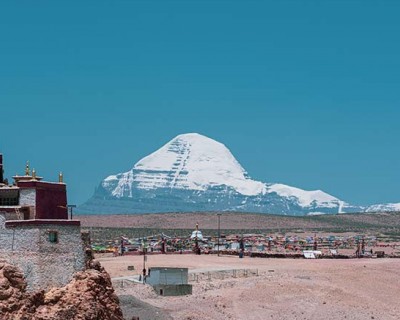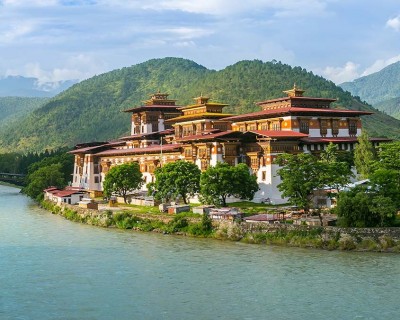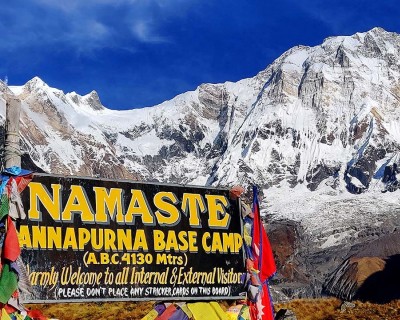Outline of Gokyo Lake Trek
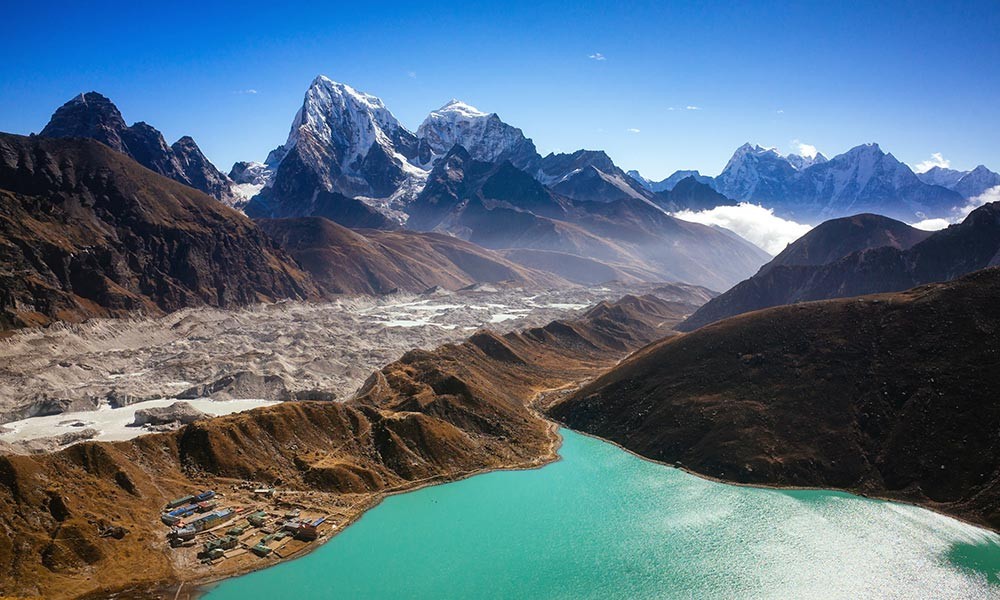
This is a general outline of the Gokyo Lake Trek, the itinerary package varies depending on the highlight exploration and trekking route. You can also get your own custom-tailored itinerary package of Gokyo Lake Trek for a more immersive and enjoyable experience.
Day 01: Fly from Kathmandu (1,300 meters) to Lukla (2,850 meters) and trek down to Phakding (2,650 meters)
Day 02: Trekking from Phakding to Namche Bazaar (3,440 meters)
Day 03: Rest and exploration day at Namche Bazaar
Day 04: Namche Bazaar to Dole (4,200 meters) trekking
Day 05: Trekking from Dole to Machhermo (4,470 meters)
Day 06: Machhermo to Gokyo Lake (4,790 meters) trek
Day 07: Early morning hike to Gokyo Ri (5,357 meters) and trek down to Dole
Day 08: Trek down to Namche Bazaar from Dole
Day 09: Namche Bazaar to Lukla trekking
Day 10: Fly back to Kathmandu from Lukla
Best Time for Gokyo Lake Trek
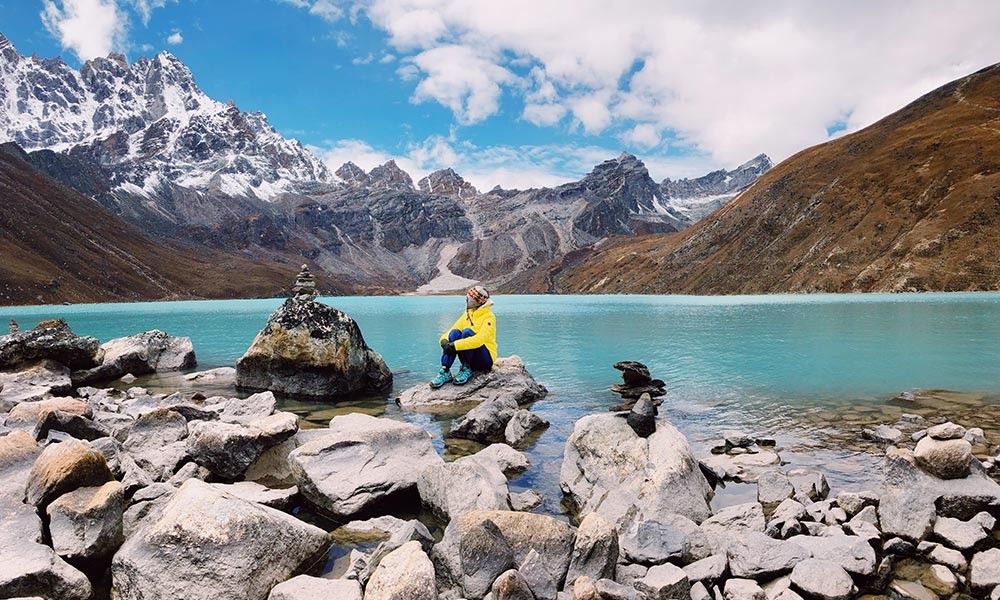
If you want to truly immerse in this iconic Himalayan expedition of pristine glacial lakes, the ideal time frame is during spring (March to May) and autumn (September to November).
Both of these seasons are also known as the peak seasons for high Himalayan trekking and mountain expeditions. The weather is calm and stable during these peak seasons, the trekking trails are dry and the temperature is suitable for outdoor adventures.
The spring season in the Himalayas welcomes blooming vegetation throughout the region. Your trekking route is decorated with dotted rhododendrons and wildflowers, the pristine soaring rivers and charming waterfalls throughout the region will make it seem like you have entered an enchanted paradise.
Spring season is also the perfect time for wildlife and nature photography. The temperature of the Gokyo Lake region averages around 15° C to 22° C.
Similarly, another peak season, autumn, is known for its pleasant temperature, fresh landscapes washed by the monsoon rain, and clear unobstructed views of the Himalayas. The temperature of the region is around 14°C to 16°C during the daytime and you can expect the temperature to drop to minus degrees in the early morning and night.
The altitude above 4,000 meters is considered an alpine environment, so you can expect the temperature to be in minus degrees during the early mornings and nights.
Trek Difficulty Level
The overall trekking difficulty level of Gokyo Lake Trek is at a 'moderate' level. Trekkers don't need any technical skills or previous high-altitude trekking experience to do this trek. However, it will be helpful if you have any previous high-altitude trekking experience.
Although the difficulty level of Gokyo Lake Trek is at a moderate level, it is still a high Himalayan adventure. You will have to consider the several difficulty factors of this expedition that can be challenging during your exploration.
Let's break out some of the major difficulty factors of this trek that you will have to deal with during your adventure.
Altitude Sickness
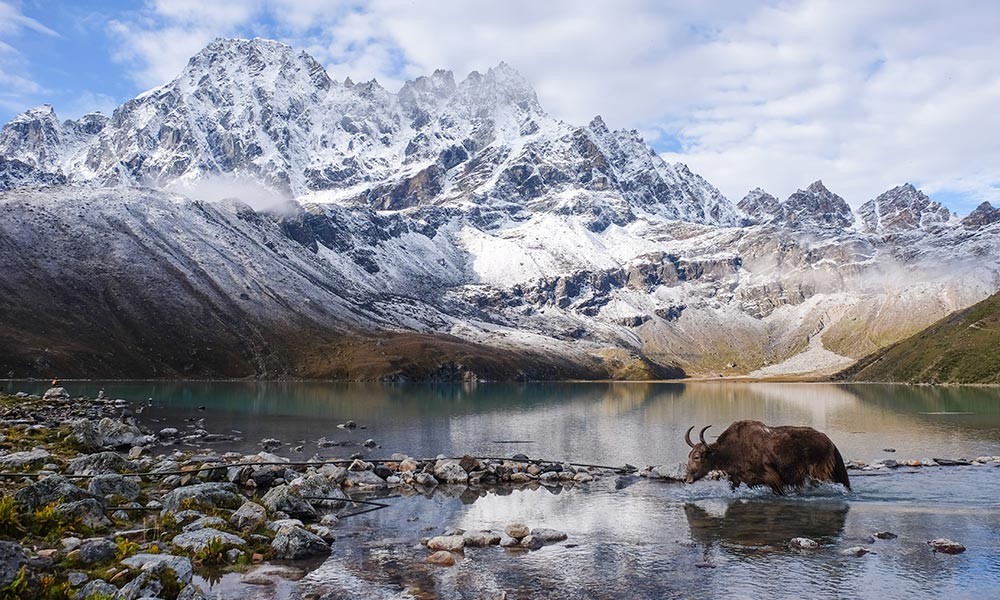
The risk of altitude sickness is a major concern in any high-altitude adventure. As there are risks of altitude sickness on the altitude over 2,500 meters, Gokyo Lake Trek which take you to altitude above 4,000 and 5,000 meter poses great risks for altitude sickness if you are not well prepared.
You will start your adventure from Lukla (2,850 meters) which already exceeds the altitude above 2,500 meters where the risk of altitude sickness may occur. Moving along your trekking route you will overcome other high-altitude jump points like Dole (4,200 meters),Gokyo Lake (4,790 meters), and the highest elevation point Gokyo Ri (5,357 meters).
So, you will need to acclimatize well to minimize the risk of altitude sickness, stay hydrated, get enough rest, eat a balanced diet, and stay on the lookout for any symptoms of altitude sickness during your Himalayan adventure.
Trekking Distance
Another major difficulty factor that you have to overcome during your Gokyo Lake Trek is the trekking distance. You will cover approximately 92 km (57 miles) of distance during your trekking adventure, about 6-7 hours of trekking distance during every day of your adventure.
It may not be that much of a big deal for trekkers who have previous high-altitude trekking experience and those who are physically active. But, trekking for such long hours at rising altitudes and carrying your backpack on top of that is not an easy feat for a beginner. Only with a sufficient amount of training the challenges of these demanding trekking can be overcomed.
Climatic Conditions
Although it is true that for the best Gokyo Lake Trek experience, peak seasons are the most ideal. However, the high Himalayan altitude can be unpredictable at times, it doesn't take that much time for a sunny warm day to be covered by chilly snow clouds.
So, you will have to be prepared for any kind of climatic conditions thrown your way. The weather is generally stable and calm in the peak seasons but if your adventure is timed for the off-season like winter (December- February) or monsoon (June- August), you will have to face more climate-related issues during your adventure.
The upper trekking trail is covered in snow during the winter season and it is the coldest season in the region. The heavy snowfalls, freezing high-altitude winds, and blizzards are pretty common in the Gokyo Lake Trek region during the season. As for the monsoon, the continuous downpours, slippery trekking trails, and natural disasters like floods and landslides make the trek extremely difficult and dangerous.
Remoteness
Yes, trekking is one of the most exhilarating and iconic high-altitude adventures, but what many newcomers often forget to account that it is also a remote exploration. Gokyo Lake Trek like other high Himalayan trekking adventures takes place in a remote part of the country with limited facilities and technologies.
If you are expecting the services and amenities of an exotic vacation destination, you will end up disappointed. You will be able to enjoy a moderate level of service and amenities during your trekking adventure. But, as the development of the region is pretty much limited due to the lack of proper mode of transportation, health facilities, electricity, internet, and other modern amenities are only available in the lower regions.
Is This Trek Suitable for Me?
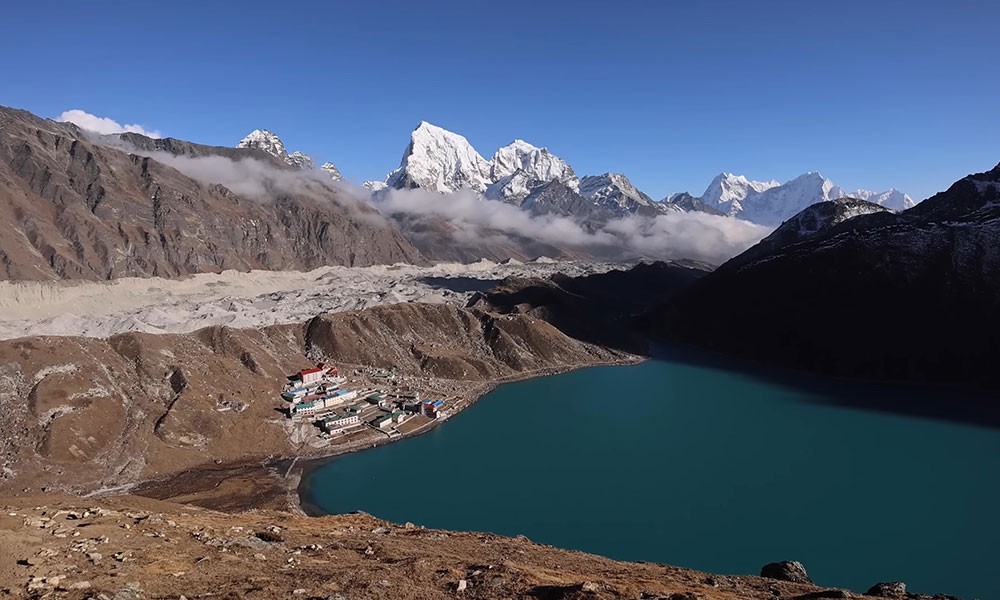
After considering the overall trekking difficulty level, if you are wondering whether the Gokyo Lake Trek might be the right choice for you or not. Rest assured, this moderately difficult Himalayan expedition that explores the pristine glacial lakes is a perfect adventure for you.
With the right amount of training and preparation, you will be able to easily complete this iconic trekking expedition. If you have a good health condition and a basic level of fitness, Gokyo Lake Trek will be a piece of cake for you. However, in case if you have any medical conditions, you should consult your physician and guide about the trekking adventure.
The success rate of Gokyo Lake Trek is 95% to 98%, which is significantly higher than other base camp adventures in the country. So, you will be able to easily complete this expedition if you are determined and are willing to make efforts to overcome the difficulty level of this adventure.
Training and Preparation
Although the Gokyo Lake Trek is not as base camp trekking or the scaling of the trekking peaks, it is still a demanding trekking adventure. You have to overcome the 4,000-meter and 5,000-meter altitude margin in this adventure, so it's best if you are well prepared for the adventure.
The recommended period for high-altitude trekking adventure in the Himalayas is approximately 8- 12 weeks. If you exercise on a regular basis or you are in sports, you can decide the training period and exercises that suit your needs.
However, if you don't exercise a lot, you need to effectively manage your time and exercises to prepare for the Gokyo Lake Trek. It is recommended that you should emphasize strength and endurance exercises to have an enjoyable and memorable experience.
Here are some exercises that you can include in your training program.
Strength Exercises
- Push up
- Pull up
- Squat
- Deadlift
- Plank
- Weightlift
- Lunge
- Hammer curl
- Dip
- Front raise
- Step-up
- Leg press
- Leg extension
- Upright row
Cardiovascular Exercises
- Jogging
- Swimming
- Dancing
- Power walking
- Aerobics
- Lateral shuffle
- Rowing
- Jumping ropes
- Cardio
- Cycling
** Note: As you will have to overcome several steep sections during the Gokyo Lake Trek, it is recommended that you should do some practice hikes on the natural steep sections. This will give you a proper idea about what you can expect during your actual, further, carrying a backpack with significant weight will prepare you for the day-to-day trek in your Himalayan adventure**
Gokyo Lake Trek Cost
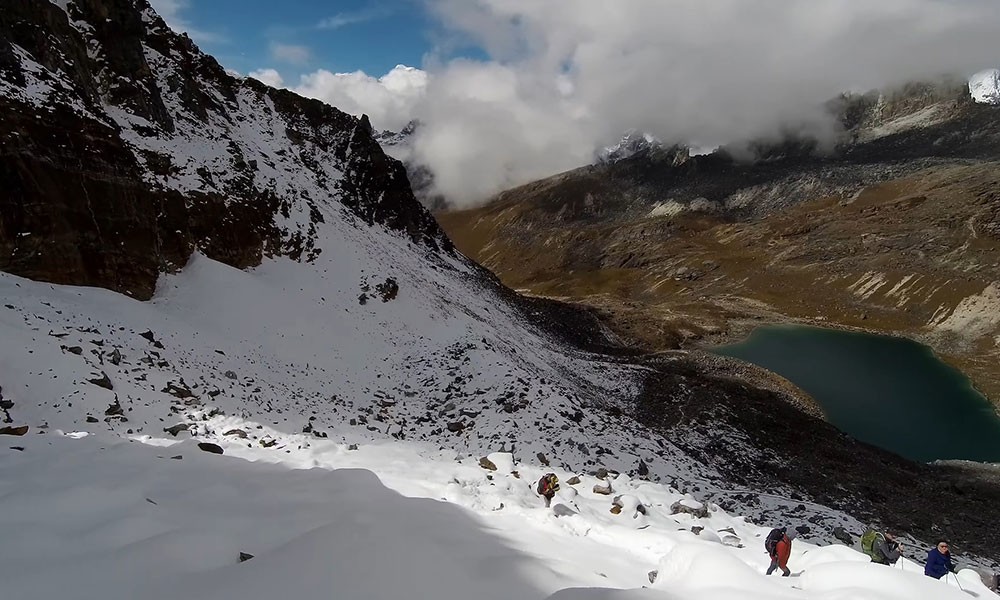 The Gokyo Lake Trek cost is generally around US$ 1,300 to US$ 2,200, the overall cost of the trekking package depends on the itinerary days, quality of services- amenities, and the highlight exploration during the expedition. There are also longer variant of the the Gokyo Lake Trek that explores the Everest Base Camp route as well as the high Himalayan passes in the Khumbu region which are slightly more costly.
The Gokyo Lake Trek cost is generally around US$ 1,300 to US$ 2,200, the overall cost of the trekking package depends on the itinerary days, quality of services- amenities, and the highlight exploration during the expedition. There are also longer variant of the the Gokyo Lake Trek that explores the Everest Base Camp route as well as the high Himalayan passes in the Khumbu region which are slightly more costly.
Marvel Adventure offers the best value Gokyo Lake Trek package at just US$ 1,199 if you take advantage of the group discounts and special offers, your Gokyo Lake Trek may cost even less without compromising the integrity of the services.
Our trekking package all the expenses including the permits, TIMS Card, food, accommodation, guides, porters, flights (Lukla- Kathmandu, including government expenses, and official service charges. There are no any kind of hidden costs in your Gokyo Lake Trek cost.
Food and Accommodation
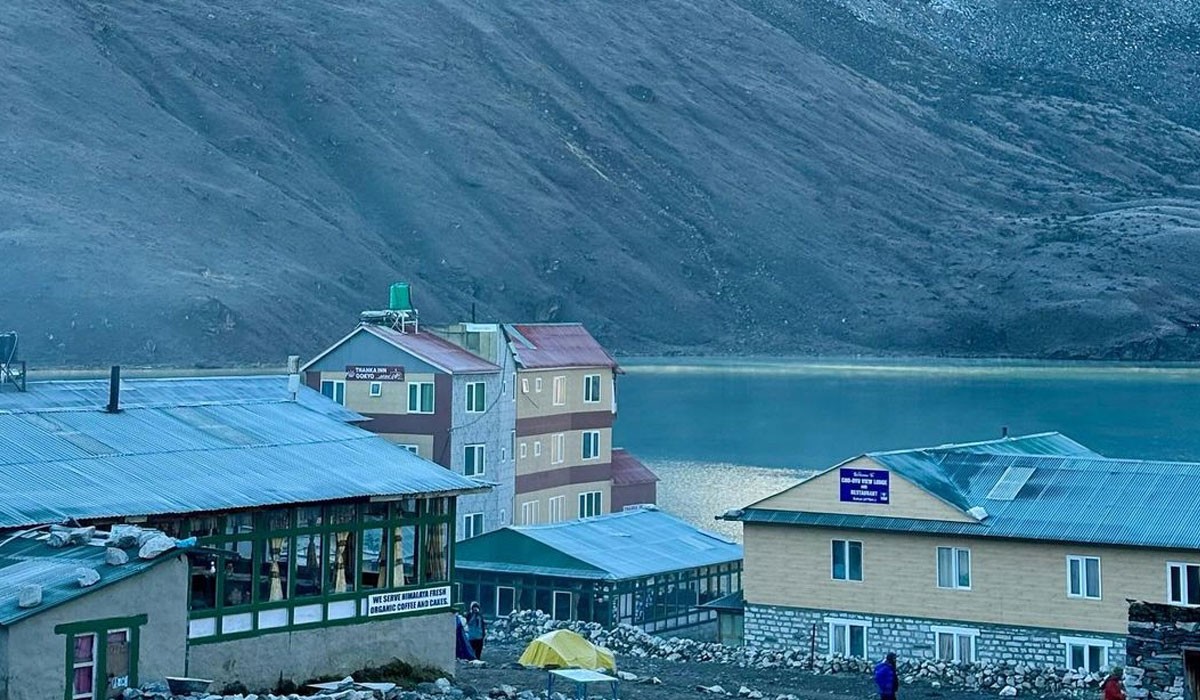 As the Gokyo Lake Trek follows the mainstream trekking route of Everest Base Camp Trek till Namche, you can expect a good level of service and amenities during your expedition. For food, you will be able to enjoy a diverse range of local delicacies including Tibetan culture-influenced dishes as well as some of the popular continental menus during your trek.
As the Gokyo Lake Trek follows the mainstream trekking route of Everest Base Camp Trek till Namche, you can expect a good level of service and amenities during your expedition. For food, you will be able to enjoy a diverse range of local delicacies including Tibetan culture-influenced dishes as well as some of the popular continental menus during your trek.
You can expect the following food menus at the teahouses on the route of Gokyo Lake Trek.
For Breakfast
- Bread
- Eggs
- Sandwich
- Porridge
- Corn flakes
- Pancake
- Oats
- Pudding
- Cereals
- Papad
- Paratha
- Chapati
- Salad
- Fruits
For Lunch and Dinner
- Daal bhat tarkari (Lentil soup, steamed rice, vegetables and side dishes)
- Pizza
- Momo
- Chowmein
- Spaghetti
- Macaroni
- Pie
- Pasta
- Spring rolls
- Steak
- Shyakpa
- Thukpa
- Riki kur
- Soup
**Note: Vegan and vegetarian options are also available throughout the region, you can request your guide or chef to prepare meals excluding the ingredients you don't want at the teahouses**
Beverages
During your Gokyo Lake Trek, you can enjoy a variety of beverages from soft drinks to hard drinks. From canned juice to cold drinks and alcoholic beverages, you will able to enjoy a refreshing beverage of your choice during Gokyo Lake Trek.
As for water, bottled mineral water bottles are available throughout the trekking route. However, as they can be expensive, costing upto US$ 3 - US$ 5 it is not the best alternative for drinking water.
The best way to consume water during your expedition (recommended quantity: 3-4 liters per day) is to use the boiled water at teahouses, you can use purification solutions and tablets to stay on the safe side. Although tap water is available throughout the trekking route, it's not safe to drink.
**Note: Alcoholic beverages are not recommended during Gokyo Lake Trek as they complicate the acclimatization process as well as put your life at risk during this high-altitude adventure**
Accommodation
Gokyo Lake Trek is a unique mixed adventure of both teahouse trekking and camping adventure. During the camping part, your expedition crew will take care of accommodation and prepare the campsite at a safe and comfortable spot.
As for the teahouse part, you can expect a well furnished warm and comfortable rooms during your stay. Mostly, you will use a shared room with 2-3 adjacent beds. You will be provided with a comfortable mattress and a set of pillows and blankets. Similarly, in the case of bathroom facilities, you will use the shared bathroom at the teahouses.
The lower regions of this mainstream trekking route are well facilitated with modern technology and amenities. You can enjoy luxurious as well as moderate level of accommodation facilities, however, the services of high altitude region are limited due to its remoteness and lack of proper transport mode.
In case you just missed it:
What to pack for the Gokyo Lake Trek?
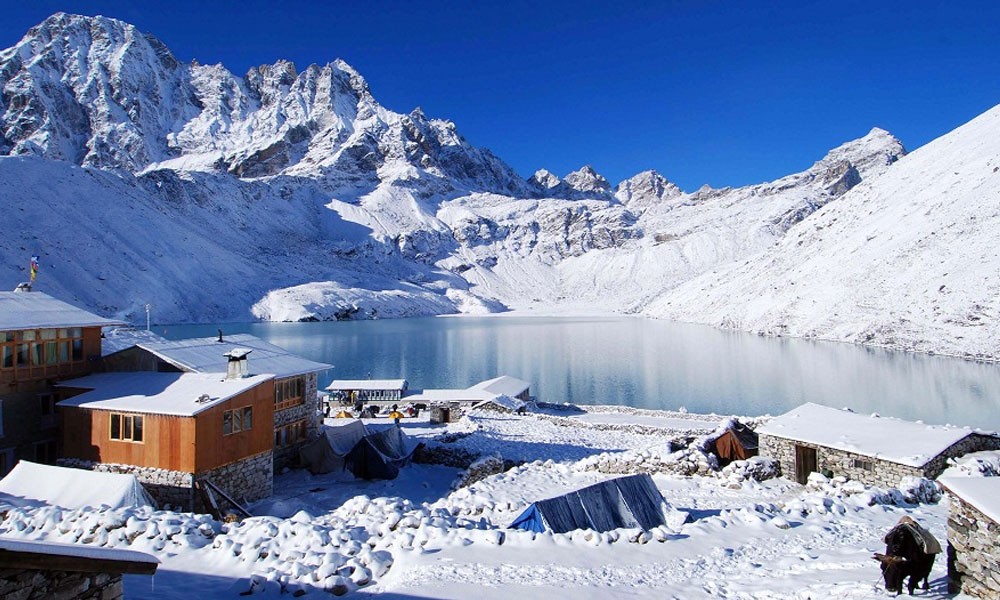
For a comfortable and enjoyable experience in this epic Himalayan quest, you need to make sure to pack right. During Gokyo Lake Trek, you will traverse across diverse terrain and climatic regions, so you need to pack accordingly befitting the different climatic zones.
Although you are recommended to pack light for the trek, you don't want to miss out on the most essentials in your backpack. Here are some packing suggestions for the Gokyo Lake Trek.
Clothes
- Sun hat/ brimmed (for sun protection)
- Woolen hat, knit hat (for alpine environment)
- Scarf, bandana, neck gaiter
- Multiple pairs of t-shirts (sleeveless and sleeves)
- Light-weight thermal
- Light jacket (waterproof and windproof)
- Insulated jacket
- Heavy down jacket (puffer)
- Thermal trousers
- Hiking pants (shorts and full)
- Down/insulated trousers
- Woolen trouser
- Several pairs of undergarments
Footwear and Handwear
- Gloves (light and woolen)
- Hiking boots
- Water gaiter
- Multiple pairs of socks (different thicknesses)
- Training or sports shoes ( for short hikes and campsites)
- Sandals/slippers (for resting at the teahouse)
Personal Hygiene and Toiletries
- Toothbrush, toothpaste, dental floss
- Skincare, lotion, lip balm, sun protection cream
- Soap, shampoo, conditioners
- Deodorants
- Toilet paper, face wipes, quick-drying towel
- Female hygiene products
- First aid kit (small with all the basic medications including for altitude sickness)
- Personal medications
Gadget and Accessories
- Headlamp with extra pair of batteries
- Sunglasses, binoculars, and camera
- Trekking poles
- Sleeping bags (four seasonal)
- Water bottle, thermos
- Dry bags and packing cubes
- Solar charger, power bank
- Jourmals, magazine, pen
- Board games, card games, entertainment set
**Note: As you will be traveling in the remote part of the Himalayas the ATM services are limited to lower regions only, so, you need to convert enough cash to local currency which comes in handy while buying snacks and souvenirs**
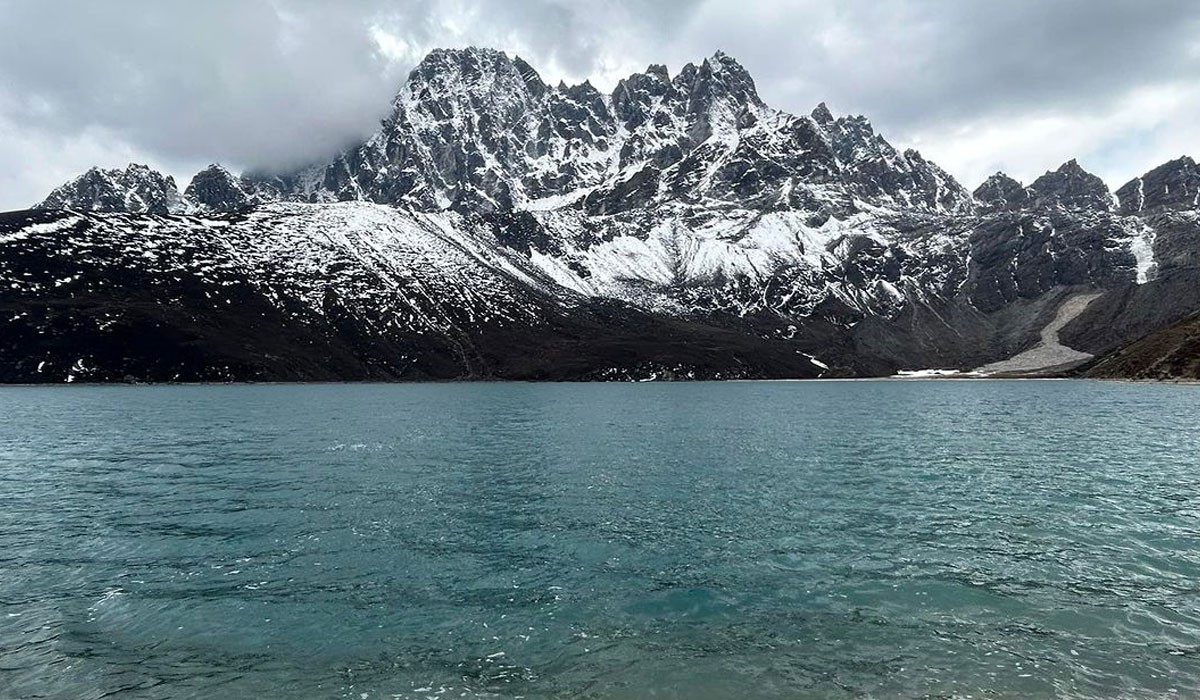


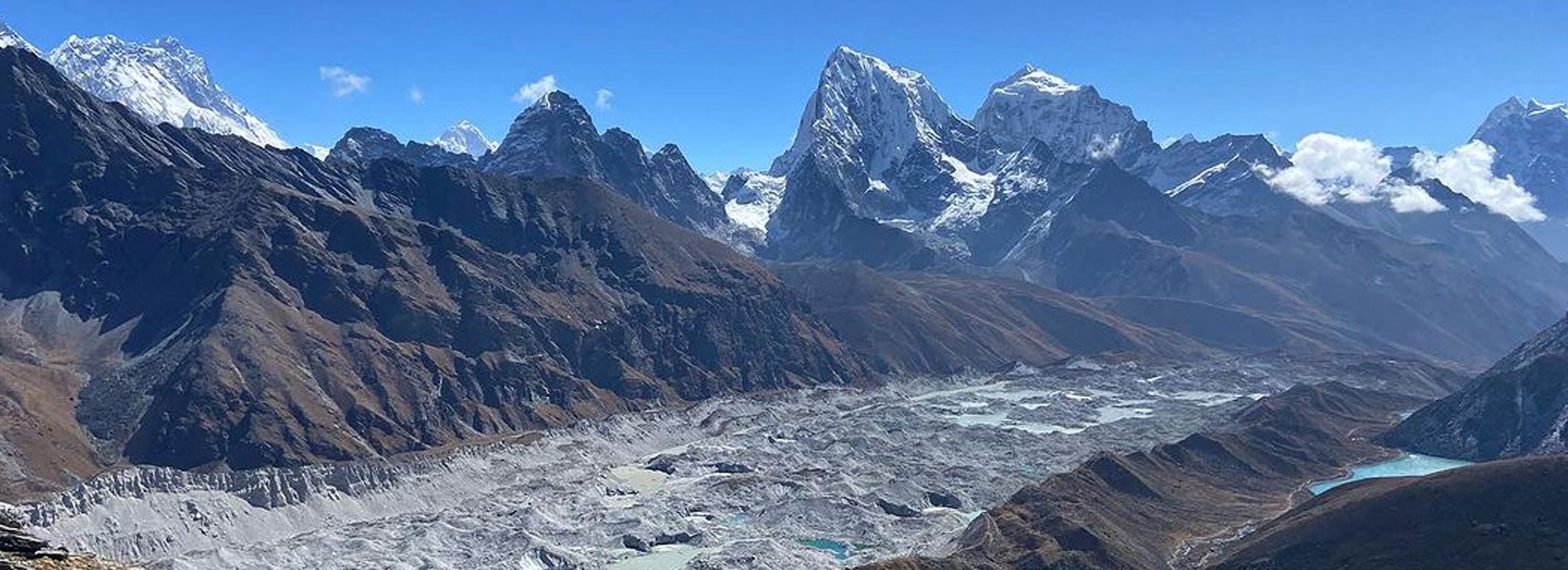




 The Gokyo Lake Trek cost is generally around US$ 1,300 to US$ 2,200, the overall cost of the trekking package depends on the itinerary days, quality of services- amenities, and the highlight exploration during the expedition. There are also longer variant of the the Gokyo Lake Trek that explores the Everest Base Camp route as well as the high Himalayan passes in the Khumbu region which are slightly more costly.
The Gokyo Lake Trek cost is generally around US$ 1,300 to US$ 2,200, the overall cost of the trekking package depends on the itinerary days, quality of services- amenities, and the highlight exploration during the expedition. There are also longer variant of the the Gokyo Lake Trek that explores the Everest Base Camp route as well as the high Himalayan passes in the Khumbu region which are slightly more costly. As the Gokyo Lake Trek follows the mainstream trekking route of Everest Base Camp Trek till Namche, you can expect a good level of service and amenities during your expedition. For food, you will be able to enjoy a diverse range of local delicacies including Tibetan culture-influenced dishes as well as some of the popular continental menus during your trek.
As the Gokyo Lake Trek follows the mainstream trekking route of Everest Base Camp Trek till Namche, you can expect a good level of service and amenities during your expedition. For food, you will be able to enjoy a diverse range of local delicacies including Tibetan culture-influenced dishes as well as some of the popular continental menus during your trek.
